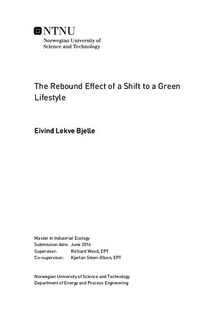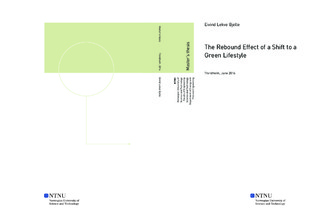| dc.description.abstract | Reaching the 2°C target of global warming, requires a 40-70% reduction in anthropogenic greenhouse gas emissions. Norwegian policy makers have implemented a term called The Green Shift that involves a transition into products and services associated with a substantial reduction in negative consequences for the climate. The focus is primarily on the role of the government, business, and technology improvements to achieve the needed reduction. However, studies show that this might not be enough, which calls for changes on the consumption side.
Households can contribute by adapting a green lifestyle comprising of a set of actions associated with cost reductions and reductions in greenhouse gas emissions. Rather than decreasing overall consumption, the assumption is total re-spending of the money saved from implementing the set of actions to avoid contributing to potential recession. This re-spending leads to additional greenhouse gas emissions, offsetting some of the reductions achieved in the first stage, a phenomenon known as the rebound effect. Although there is much focus on reducing the carbon footprint of households, the rebound effect receives less attention.
Cost changes and reductions in greenhouse gas emissions build on findings in the literature. Data from the Norwegian consumer expenditure survey serves as the basis for developing scenarios of re-spending. Calculations on rebound effects involve the use of input-output analysis, using EXIOBASE2, a multi-regional environmentally extended Input Output database. Optimization by linear programming approaches examine the needed changes by households to reach different emission reduction targets.
Implementing the green lifestyle without re-spending shows a 58% decrease in an average Norwegian household s carbon footprint. When including re-spending, the reduction drops to 24-35% depending on the pattern of re-spending. The analysis shows that the key to reducing household carbon footprints to the requirements within the 2°C target of global warming is to curb the rebound effect. The linear programming results suggest that through implementing a pattern of re-spending restricted to specific goods and services, households can achieve up to a 50% reduction in carbon footprint with the lifestyle changes suggested. Increased focus on household behavioral changes combined with production side measures can provide the key to achieving the 2°C target of global warming. | |

